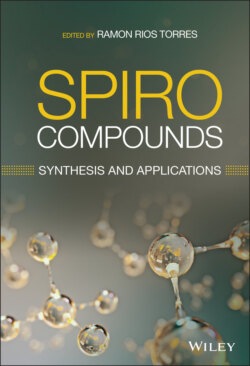Читать книгу Spiro Compounds - Группа авторов - Страница 27
3.3.1 Organocatalytic [3+2] Cycloaddition Strategies to Construct Spiro Compounds
ОглавлениеThe group of Glorius envisaged an a3–d3 umpolung reactivity strategy of β,β‐disubstituted enals to construct spirocyclic oxindoles 146 bearing two highly congested contiguous quaternary carbon centers (Scheme 3.14) [26]. In this manner, the diastereoselective annulations of a variety of isatins 147 with β,β‐disubstituted enals 148 were successfully developed under N‐heterocyclic carbene catalysis 149. The use of a pivalic acid as Brønsted acid cocatalyst revealed crucial in order to ensure high yields and diastereoselectivities (8 : 1–>20 : 1 dr and 68–98% yields). Moreover, the authors carried out an enantioselective variant using a chiral NHC catalyst where the acid cocatalyst also had a beneficial effect on the reaction enantioselectivity (one example, 84% ee). The authors proposed that after the formation of Breslow intermediate, the acid cocatalyst stabilizes the intermediate 150 via two hydrogen bonds, promoting the diastereoselective formation of the adduct 151. Subsequently, intramolecular attack of the alkoxide moiety at the carbonyl group in 151 affords the desired spirooxindole 146 and regenerates the NHC catalyst.
Scheme 3.14 Conjugate umpolung of β,β‐disubstituted enals and isatins promoted by N‐heterocyclic carbene/Brønsted acid dual catalysis.
Source: Modified from Li et al. [26].
Substrates that bear multiple nucleophilic and electrophilic sites are highly useful syntons to rapidly generate architecturally complex molecules and bioactive compound libraries. In this context, Sun and coworkers reported a method for the construction of five‐membered spirocyclic oxindoles 160 based on a Michael–Mannich cascade reaction of a ketimine intermediates, characterized by a dichotomous reactivity profile, with methyleneindolinones 1 (Scheme 3.15) [27]. The one‐pot process is catalyzed by the bifunctional quinine‐derived squaramide 161 in an enatioselective fashion. Several β‐dicarbonyl substrates 162 bearing different alkyl chains and both electron‐withdrawing and electron‐donating groups on the aryl ring of the methyleneindolinone 1 and the nitrosoarene 163 are well tolerated (31–94% yields, >20 : 1 dr and 95–99% ee). Also, various electron‐withdrawing groups (R4) at the methylene position afforded the desired products with high stereocontrol. Control experiments pointed out the importance of the Boc group as a hydrogen‐bond acceptor for activating the methyleneindolinones. The proposed mechanism is depicted in Scheme 3.15; enolization of acetylacetone promoted by the tertiary amine group of the bifunctional catalyst is followed by N‐selective addition to nitrosobenzene under basic conditions. The resulting ketimine is deprotonated and the methyleneindolinone is activated by the same catalyst to promote the intermolecular Michael addition. The final irreversible Mannich‐type cyclization proceeds smoothly to afford the enantioenriched spiranic products 160.
Scheme 3.15 Bifunctional squaramide‐catalyzed synthesis of enantioenriched spirocyclic oxindoles via ketimine intermediates with multiple active sites.
Source: Modified from Sun et al. [27].
Wang, Hong, and coworkers reported the first stereoselective 1,3‐dipolar cycloaddition reaction between azlactones 172 and methyleneindolinones 1 catalyzed by chiral phosphoric acids (Scheme 3.16) [28]. The methodology gives access to highly substituted 3,3‐pyrrolidonyl spirooxindole scaffolds 173, which are present in a number of natural products. The authors take advantage of the high versatility of azlactones, which under the effect of Brønsted acids can form N‐protonated 1,3‐dipoles. The dipole reacts with the methyleneindolinone 1 wherein the hydroxyl proton and the phosphoryl oxygen of the chiral phosphoric acid form double H‐bond interactions with both substrates, channeling the reaction in an enatioselective manner. The substituents on the binol backbone of the catalysts have a significant influence on the reaction enantiocontrol, where the bulkier catalyst 174 gave the best results. A wide variety of substitution patterns and functional groups on both substrates are well tolerated, affording the products 173 with good to excellent yields, diastereo‐ and enantioselectivities.
Scheme 3.16 Chiral phosphoric acid‐catalyzed enantioselective 1,3‐dipolar cycloaddition between methyleneindolinones and azlactones.
Source: Modified from Zhang et al. [28].
